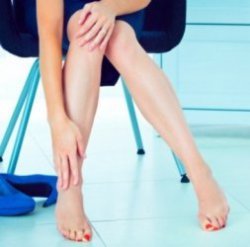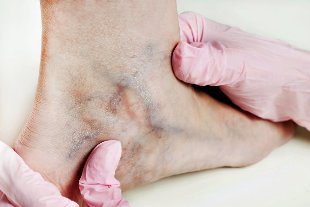The types of treatment of the leg veins on men and women did not differ, however, the frequency of recurrence post-operatively in women, due to the additional influence of hormones (the influence of its estrogenic activity).

Venous disease of the feet should be treated by a doctor-phlebologist, which is about exactly this pathology. Different methods of treatment of varicose veins are not radical, because they are not intended to solve the patogeneticheskoy the causes of the insolvency of the valve of the device of vienna. Surgical and conservative treatment can delay the progression of the disease for long lines. The percentage of recurrence is high and reaches 10 to 50% after 5 years after the surgery.
The treatment of varicose veins should be full. We distinguish three groups of methods of resolution of varicose veins:
- surgical,
- the conservatives.
Each type of treatment has its own advantages and disadvantages of a certain frequency of recurrence. The choice of the method is the conditional, because phlebologist to achieve the result most favorable, it is often necessary to combine the three methods.
The symptoms of varicose veins in women
Joint events specific to women
The symptoms of varicose vein disease begins with the appearance of functional disorders such as the feeling of heaviness in the legs, swelling of the joints of the ankle at the end of the day. On the skin of the feet, first formed the veins.
The main signs of the disease – association varicose veins, extended saphenous veins, appear at the end of a few years of the onset of the disease.
In the absence of treatment at this stage, you experience symptoms such as cramps in the calves, itching of the skin on the feet.
Signs of trophic disorders: skin pigmentation in the lower third of the leg, cyanosis, sclerotic changes of the skin and subcutaneous tissue, eczema, the context in which is formed the ulcer trophic.
The symptoms of varicose veins in women
- The painful symptoms appear to be cyclic, are amplified before monthly, which is due to the change in the level of sex hormones;
- in the course of the pregnancy is the result of the signs of varicose veins after confinement may disappear;
- in the second half of the menstrual cycle due to the action of progesterone diameter of the varicose veins increases, so that the symptoms of swelling and heaviness in the legs, are expressed more;
- the signs of varicose veins worsen during hormone therapy.
Now, let's talk about methods of therapy.
The best methods of treatment
Radiofrequency ablation and laser photocoagulation
Radiofrequency ablation veins
The method is based on the introduction of under ULTRASOUND control special single-use catheter is in the extended light of vienna.

The catheter is equipped with a working electrode including a portion under the action of radio frequency radiation is heated to 120 degrees. The promotion of a catheter in the course of vienna led to the closure of the vascular wall. The dead of vienna off from a system of blood circulation in the legs.
Venous laser photocoagulation
The technique of the operation consists of the puncture affected vienna and the introduction in its of light under ultrasound guidance a laser fiber optic. Under the action of the laser radiation occurs the coagulation of the proteins of the vascular wall, resulting from the vienna subside and after a certain time invaded the connective tissue.
Radiofrequency ablation and venous laser obliteration are relatively new treatments of varicose veins on the legs. In spite of the differences in the technique of execution, have common characteristics.
The advantages and disadvantages of radiofrequency ablation and venous laser erasing
Advantages:
- Do not require hospitalization;
- The speed of execution (from 30 min to 1 hour);
- Painless;
- Not bloody;
- Performed under local anesthesia;
- The absence of scar (desired for women cosmetically effect);
- The short time of rehabilitation.
Disadvantages:
- High price;
- The frequency of recurrence to 10%;
- The impossibility of conducting the procedure in some anatomical characteristics of veins (high tortuosity of vessels).
Radiofrequency ablation and venous laser obliteration choose women who wish to treat the spider veins in an outpatient setting with a minimum limitation of physical activity in the postoperative period and with the preservation of the aesthetic appearance of the feet.
Fleboskleroterapija
In the light affected the segment of vein introduces a drug with a specific action on the vascular wall. Sclerosing agent may be used in liquid form or in the form of a foam. Preference should be given to sparkling of sclerotherapy due to the greater surface area of contact of the substance with the wall of the vein.
The advantages and disadvantages Fleboskleroterapija:
- The absence of scar;
- Is performed as an outpatient procedure;
- The operation is performed without anesthesia;
- The procedure is virtually painless (a mild burning sensation on the site of the puncture);
- Possibility of long-term pigmentation of the skin over the puncture site (up to 2 years);
- In rare cases, dizziness, inflammation of veins (phlebitis);
- The redness and swelling of the tissues within 2 days after the procedure;
- An allergic reaction if you're hypersensitive to the drug;
- In 20% of cases appear to be spider veins on the legs (telangiectasia);
- The frequency of recurrence by up to 50%.
The recurrence of varicose veins after sclerotherapy depends on the light of the victim to a larger container number of the thinning, the greater the risk of the. This therapy for the treatment of the recurrence of varicose veins after phlebectomy.
Surgical phlebectomy
Surgery is the most radical method of varicose vein disease. The principles of surgical treatment are eradication of the disease to reset the blood from the deep into the superficial veins of the legs and of the removal from themselves of the dilated vessels. The steps combined phlebectomy:

- The intersection and ligation of the mouth of the great saphenous vein (incision in the region of the groin) or small saphenous vein (incision in the fossa popliteal);
- Remove the trunks of varicose veins. Carried out with the aid of a metal probe which draws a vein in the incision of the skin.
Advantages:
- The radicality;
- The ability to perform operations at any stage of the disease.
Disadvantages:
- The hospital stay is 5 to 7 days;
- The scar on the leg;
- Anesthesia, lumbar, or total;
- Trauma to the surrounding tissue when we draw on vienna;
- Possible complications: bleeding, infection of the wound;
- The frequency of recurrence of up to 20%.
Treat surgically, preferably if a certain type of lesion, when it occurs varicose veins the deformation of the large or small saphenous veins, since. Thus, when there are signs of trophic disorders of soft tissues and symptoms of decompensation, of venous insufficiency.
Miniflebjektomija
Miniflebjektomija – a rapid response, in which it is possible to treat spider veins of the legs at the initial stage. Most often used in the presence of the unity of varicose veins expanded nodes on the shins. Is the perforation of the skin at the top of the education and with the help of hooks stretched out and crossed the vienna. The operation does not require general anesthesia, and the overlay of the skin seams.
Conservative treatment
Begin to treat spider veins the disease of the feet is necessary for the application of medical treatment and compression therapy. Prescription drugs improve the blood circulation and the wearing medical compression jersey – the main conditions that determine the outcome of any intervention on the veins of the legs.
Drug therapy
Drugs stop the symptoms of venous insufficiency are used as pre-operative preparation and rehabilitation post-operative.
Treat special drugs spider veins on the legs a lot of time in the continuous mode, either in the form of the repeat course.
Compression therapy
Elastic compression of the feet – the main method of treatment in cases where surgery is contraindicated. As the segments of the funds, you can use elastic bandages and medical special knit: stockings, knee-highs, tights. Medical products strong, keep for a very long time source, level of compression, are comfortable when you wear it, which is essential for the women.

There are 4 classes of elastic jersey, depending on the degree of compression. Recommended to treat the varicose veins from the use of products of the class 2 in the absence of disease progression for a maximum period of 6 months and with the new app in an effort or a prolonged stay on the feet. If signs and symptoms of lesions of the valves of the deep veins, or expressed symptoms of a disorder of the lady, are allocated to the stevedores, of the class 3 to stop the progression of varicose veins.
The healing effect of compression knitwear due to:
- a decrease in the amount of vienna, which leads to a decrease of the reset of the blood vessels in the varicose;
- the increase of the aspiration of tissue fluid in the flow of blood, with signs of edema and the symptoms of heaviness in the legs disappear;
- the improvement of the fluidity of the blood, which prevents the formation of blood clots.




































